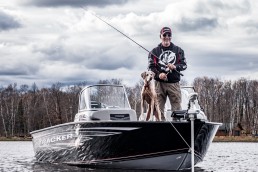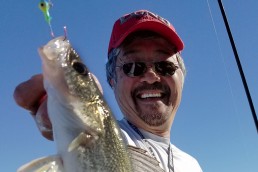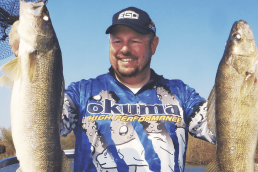Aggressive Spring Walleyes
SHARE THIS POST
Early Spring
It’s early May. Every boat seems as cold as the weather outside. Nets stay put, and casts take what seems like an hour to complete. Over the years, the Next Bite team has found that walleyes wake up to aggressive tactics earlier than we originally believed. So just because it is early season, don’t get too passive with low-action baits in cold water. This can lead to some seriously aggressive spring walleyes.
Spring walleyes may feed less than in summer, but they still normally show up in predictable locations at predictable times. Warmer water is often key. Shallow bays near spawning areas on the slightly warmer north side of the lake will have active fish every afternoon and evening. Look for rocks to help the warming process. Also, windswept shorelines often have warmer surface water pushed up on them and can generate feeding activity.
Trolling
Trolling always kicks off our season, and a few details need to be followed. We’re often fishing shallow water, so planer boards or very long flatlines rule the day. In cold water, we slow troll our Mercury 15hp EFI 4 stroke at 1 to 1.2 mph. With flatlines, we handhold the rods and occasionally (not continuously) sweep the baits forward, then drop the rod tip back. Offshore Planer Boards do this naturally as they rise and fall over waves, especially while adjusting our trolling direction or turning.
Lures like the Shallow Flicker Shad (size 5 and 7) and the new Berkley Hit Stick (size 5 to 9) activate at slow speeds and don’t dive too deep. Start out matching the hatch. To match round-bodied forage species, we use the Shallow Flicker Shad; for slender forage species, we go with the Hit Stick. We use the Precision Trolling App on our phones to show us the amount of line to let out to get the lure close to the bottom. Use Cabela’s DepthMaster Metal Line Counter Trolling Reels DMM-20 to repeat productive presentations. Berkley XT monofilament in 10-pound-test is perfect this time of year. It is very abrasion-resistant (remember, rocks are usually good areas in spring) and it’s got a little bit of stretch in it to ensure fish stay hooked up during longer trolling fights.
While large, non-descript bays, flats and long shoreline stretches beg for trolling, rocky points and wind-blown small, shallow structures need to be jigged. There is nothing better than to put the trolling motor in anchor mode off a point and catch walleyes on and off for a few hours on an unseasonably warm evening.
The Action
There are several levels of walleye aggressiveness you can match with jigs and action tails.
A rod sweep followed by holding the rod is a great action. Holding still at the top of the stroke causes the jig to pendulum towards you on a tight line—the whole while the action tail is swimming and enticing. The key is to have tails that “swim” at slow speeds.
We stay aggressive by increasing the weight of the jigs. Even in shallow water, we use 1/4- to 3/8-ounce offerings to stay in the strike zone and to guarantee that the tails of the baits activate with every jig stroke. The heavier jigs also help stay right near the bottom during constant retrieves.
Most of our experimentation with jigs comes on the upstroke—fast, slow, short, long, pop, lift—all actions that might get the fishes’ attention, but then followed by the “swim” of the jig to give them a chance to bite. Remember also that walleyes often let the jig hit the bottom and pin it down. So, when you lift, always be feeling for weight, and be ready to set the hook.
Plastics with thinner tails activate with less movement. The Berkley Powerbait Rib Worm is a classic example. The ribs make the body extra-flexible while the small curly tail flaps even at rest. The Powerbait scent has proven to us time and time again that fish will hold on to a Powerbait-infused bait, giving plenty of time to set the hook. Even an aggressive paddle tail like the Powerbait Ripple Shad works, too, especially if you gently stretch the tails a bit to limber them up. The ultra-thin tail of the 3-inch Gulp Nemesis has been an under-the-radar option, especially when rigged on Berkley Fusion19 Swimbait jig.
Are you enjoying this post?
You can be among the first to get the latest info on where to go, what to use and how to use it!
Structure
Sometimes, walleyes look up to eat. The Berkley Cutter 90+ is our go-to aggressive jerk bait for fishing points, rock and riprap. While one angler jigs, the other can throw a jerk bait to work the area. Often, a 2- to 3-foot quick pull, followed by a few quick pops of the rod tip, is our go-to action. The pull gets their attention, then the short pops make the bait look wounded—an easy meal.
Walleyes use emergent weeds not for heat, but for food. Bugs and small minnows hide and feed in the weeds as soon as they start to grow, and a small meal is just as good as a larger one for spring walleyes. Side scanning is the key to finding the newest vegetation in the lake. We look sideways to see weed growth, weed height, pockets, and rocks or stumps within the green stuff. After a few bites start to come, knowing the details of what is drawing them in helps identify other high-potential spots around the lake.
When you get around emergent weeds, this is a great time to pull out Berkley Snap Jigs with straight-tail trailers to give a new look to the fish. Over weeds, we typically swim the jig continuously, steadily popping the rod tip and then giving slack to allow the Snap Jig to jump and glide, jump and glide. The Berkley Snap Jig creates a back-and-forth glide above the vegetation. By pausing occasionally, the Snap Jig will slowly slide down into the weeds.
In shallow water, we start with 1/8-ounce jigs and a rotate between a Gulp 3-inch Minnow, 3-inch Fry, or the 3-inch Powerbait Minnow. If the area is a bit deeper, go with the 1/4- or 3/8-ounce Snap Jig. If you go to the heavier heads, then a 3.4-inch Berkley Champ Minnow is also a great option.
Cast out above the weeds and count down a bit before starting an aggressive pop-and-glide retrieve. If the weeds are sparse, let the jig hit bottom once in a while, but spend most of the time gliding it above the vegetation. This is almost a no-feel retrieve where the lure hangs “in space” and fish move up to ea itt. These are not slow presentations. Keep moving, cast quickly, and work these baits through the area.
The Gear
For jigging rods, a medium-light rod is normally perfect. Pick one like the Cabelas Prodigy spinning rod with a fast tip. It is very lightweight and sensitive to feel the subtlest bite, but the fast tip will get you into the stiff backbone on the hookset. For most jigging, a 6’ 3” rod is best spooled with 8-pound Berkley Ultra 8 Fireline (Crystal). Add a 2-foot leader of Berkley Professional Grade 100% Fluorocarbon and direct tie to the jig
Often, anglers think “super slow” in the spring, but often the fish need to be coaxed into biting by triggering them with somewhat aggressive techniques. Cold, early season walleye fishing doesn’t mean you have to be passive to get the next bite.
Become a MidWest Outdoors Insider here!
MWO
SHARE THIS POST
Did you enjoy this post?
You can be among the first to get the latest info on where to go, what to use and how to use it!
Parsons/Kavajecz
Gary Parsons and Keith Kavajecz are professional walleye anglers specializing in tournament fishing and walleye fishing promotions. Both are “Legendary Angler” inductees into the National Fresh Water Fishing Hall of Fame, accomplished authors and co-hosts of the popular The Next Bite TV show. For more info: thenextbite.tv.



